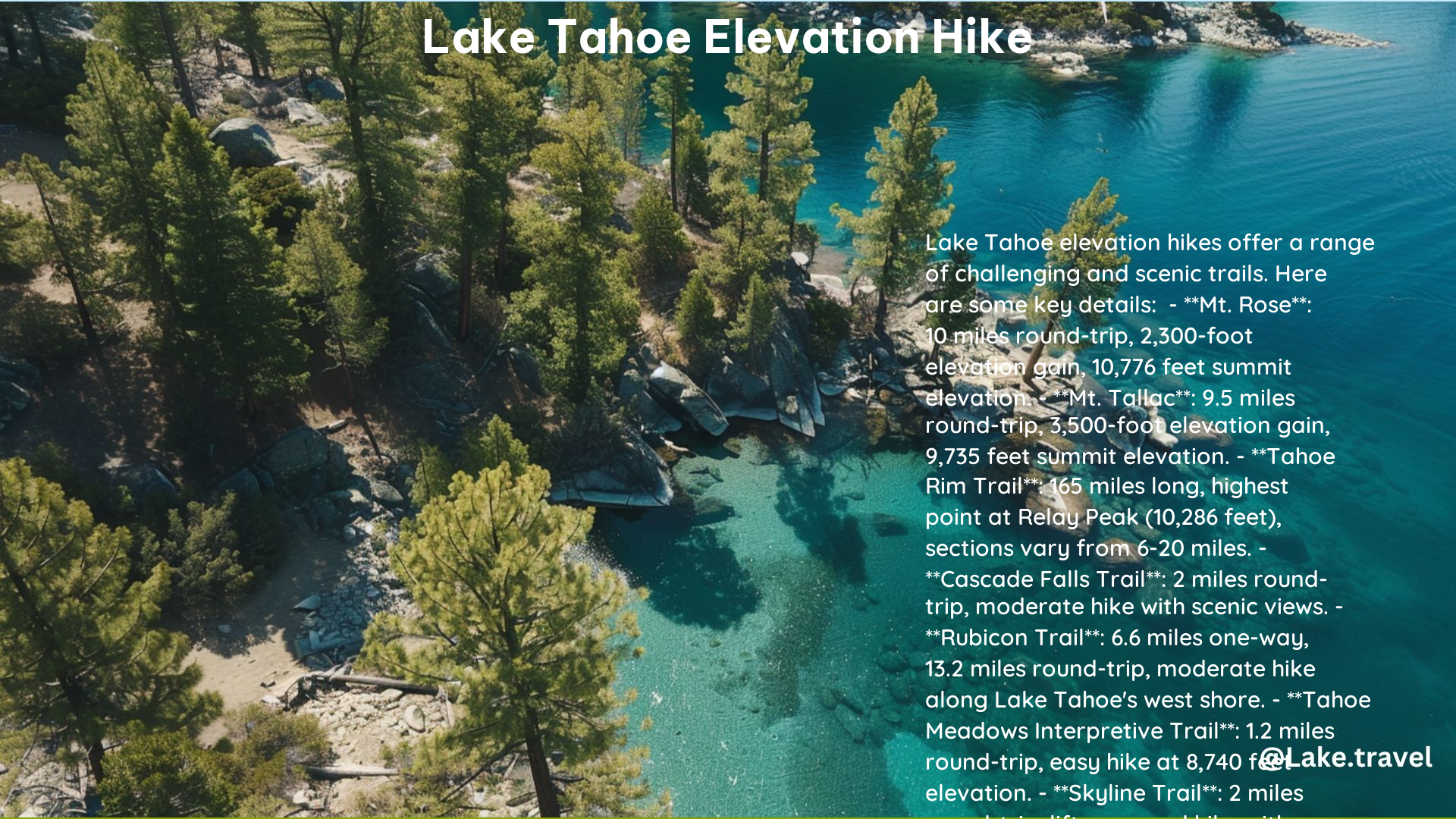Lake Tahoe, nestled in the heart of the Sierra Nevada mountains, offers a diverse range of hiking trails that cater to hikers of all skill levels. With its stunning vistas, crystal-clear waters, and challenging elevation gains, the Lake Tahoe region is a true paradise for outdoor enthusiasts. In this comprehensive guide, we’ll explore the unique characteristics of Lake Tahoe’s elevation hikes, providing you with the essential information to plan your next adventure.
Navigating the Elevation Challenges
Hiking in the Lake Tahoe region can be a thrilling yet demanding experience, thanks to the area’s high elevation. The average elevation of Lake Tahoe is around 6,225 feet, and many of the hiking trails in the area involve significant elevation gains. This can have a significant impact on hikers, especially those who are not accustomed to the thinner air and increased physical demands.
Acclimatization and Physical Demands
Before embarking on a Lake Tahoe elevation hike, it’s crucial to allow your body time to acclimate to the high altitude. Spending a few days in the area can help your body adjust to the lower oxygen levels, reducing the risk of altitude sickness and other health concerns. Additionally, hikers should be prepared for increased fatigue and physical demands due to the thinner air, which can make even the most moderate hikes feel more challenging.
Elevation Gain and Trail Characteristics
The elevation gain on Lake Tahoe’s hiking trails can vary significantly, ranging from a few hundred feet to over 3,500 feet. For example, the Mount Tallac Trail, one of the region’s most challenging hikes, features an elevation gain of 3,500 feet over a 9.5-mile round-trip route. Other trails, such as the Cascade Falls Trail and the Rubicon Trail, offer more moderate elevation gains while still providing breathtaking views of the lake and surrounding landscape.
Exploring the Trails

Lake Tahoe’s hiking trails offer a diverse range of experiences, catering to hikers of all skill levels. From the challenging Mount Tallac Trail to the more accessible Vikingsholm Trail, there’s a hike for everyone in this stunning natural setting.
Mount Tallac Trail
The Mount Tallac Trail is a challenging 9.5-mile round-trip hike that rewards adventurous hikers with stunning views of Emerald Bay, Cascade Lake, and the Desolation Wilderness. With an elevation gain of 3,500 feet, this hike is not for the faint of heart, but the panoramic vistas make the effort well worth it.
Cascade Falls Trail
For those seeking a more moderate hike, the Cascade Falls Trail is a 2-mile round-trip route that showcases the beautiful Cascade Lake and its cascading waterfall. This trail is best enjoyed in the spring when the waterfall is at its peak.
Tahoe Rim Trail (TRT)
The Tahoe Rim Trail is a 165-mile trail that circles the entirety of Lake Tahoe, offering a variety of day hikes ranging from 6 to 20 miles. This trail is suitable for hikers of all skill levels and provides breathtaking views of the surrounding landscape.
Rubicon Trail
The Rubicon Trail is a 6.6-mile one-way hike along the west shore of Lake Tahoe, offering panoramic views of the lake, surrounding cliffs, coves, and waterfalls. This trail is a popular choice for those seeking a scenic and moderately challenging hike.
Essential Gear and Preparation
Hiking in the Lake Tahoe region requires careful preparation and the right gear to ensure a safe and enjoyable experience. Here are some essential items to consider:
| Item | Importance |
|---|---|
| Water | Staying hydrated is crucial, especially at high elevations. |
| Snacks | Bring energy-rich snacks to maintain your energy levels. |
| Map | A map can help you navigate the trails and avoid getting lost. |
| Lightweight Waterproof Jacket | Unexpected weather changes can occur, so a lightweight jacket is essential. |
| Sunblock and Lip Balm | Protect yourself from the intense sun exposure. |
| Bug Spray | Insect bites can be a nuisance, so bring bug spray. |
| First Aid Kit | A small first aid kit can be invaluable in case of minor injuries. |
| Pocket Knife | A small pocket knife can be useful for various tasks. |
| Hat | Wear a hat to protect your face and head from the sun. |
| Warmer Layer | Bring an extra layer for colder weather conditions. |
| Camera | Capture the stunning scenery with a camera. |
| Headlamp | A small headlamp can be helpful if you hike late in the day. |
In addition to the essential gear, it’s important to obtain wilderness permits for any overnight trips in the backcountry and to check trail conditions before embarking on your hike.
Conclusion
Lake Tahoe’s elevation hikes offer a unique and challenging experience for outdoor enthusiasts. By understanding the impact of the high elevation, preparing with the right gear, and exploring the diverse range of trails, hikers can fully immerse themselves in the breathtaking natural beauty of this Sierra Nevada gem. Whether you’re a seasoned hiker or a newcomer to the area, Lake Tahoe’s elevation hikes are sure to leave a lasting impression.
References
- AllTrails. (n.d.). 10 Best Trails and Hikes in South Lake Tahoe. Retrieved from https://www.alltrails.com/us/california/south-lake-tahoe
- Visit Lake Tahoe. (2023). Six Great Hikes in Lake Tahoe. Retrieved from https://visitlaketahoe.com/things-to-do/hikes/great-hikes-in-tahoe/
- Visit Reno Tahoe. (n.d.). North Lake Tahoe Hiking Trails. Retrieved from https://www.visitrenotahoe.com/things-to-do/outdoor-activities/lake-tahoe-hiking
- LakeTahoe.com. (n.d.). TOP 10 Hikes in Lake Tahoe. Retrieved from https://www.laketahoe.com/top-10-hikes-in-lake-tahoe
